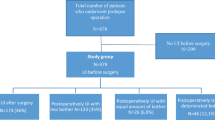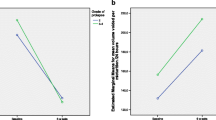Abstract
This study aims to evaluate the changes of overactive bladder symptoms to anterior vaginal wall prolapse repair. Ninety-three consecutive women with symptomatic anterior vaginal wall prolapse ≥ stage II and coexistent overactive bladder symptoms were prospectively studied using a urinalysis, urodynamics, King’s Health Questionnaire (KHQ), Prolapse Quality of Life (P-QOL) questionnaire and pelvic organ prolapse quantification (POP-Q) system before and 1 year after surgery. All women underwent a standard fascial anterior repair. Postoperatively, urinary frequency, urgency and urge incontinence disappeared in 60, 70 and 82% of women respectively (p value < 0.001). The vaginal examination findings as well as the quality of life of the women assessed using KHQ and P-QOL significantly improved after surgery (p value < 0.001). This study has demonstrated that anterior vaginal repair does produce significant improvement in overactive bladder symptoms. A larger longer-term study is required to assess if these changes persist over time.
Similar content being viewed by others
References
Cardozo L (1997) Urogynaecology. Churcill Livingstone, London
Beck RP, McCormick S, Nordstrom L (1991) A 25-year experience with 519 anterior colporrhaphy procedures. Obstet Gynecol 78(6):1011–1018
Handa VL, Garrett E, Hendrix S, Gold E, Robbins J (2004) Progression and remission of pelvic organ prolapse: a longitudinal study of menopausal women. Am J Obstet Gynecol 190(1):27–32
Versi E, Harvey MA, Cardozo L, Brincat M, Studd JW (2001) Urogenital prolapse and atrophy at menopause: a prevalence study. Int Urogynecol J Pelvic Floor Dysfunct 12(2):107–110
Digesu GA, Chaliha C, Salvatore S, Hutchings A, Khullar V (2005) The relationship of vaginal prolapse severity to symptoms and quality of life. BJOG 112(7):971–976
Fernando RJ, Thakar R, Sultan AH, Shah SM, Jones PW (2006) Effect of vaginal pessaries on symptoms associated with pelvic organ prolapse. Obstet Gynecol 108(1):93–99
Brading AF, Turner WH (1994) The unstable bladder: towards a common mechanism. Br J Urol 73(1):3–8
Abrams P, Cardozo L, Fall M et al (2002) The standardisation of terminology of lower urinary tract function: report from the Standardisation Sub-committee of the International Continence Society. Neurourol Urodyn 21:167–178
Milsom I, Abrams P, Cardozo L et al (2001) How widespread are the symptoms of an overactive bladder and how are they managed? A population-based prevalence study. BJU Int 87(9):760–766
Cardozo L, Coyne KS, Versi E (2005) Validation of the urgency perception scale. BJU Int 95(4):591–596
Cardozo LD (1990) Role of estrogens in the treatment of female urinary incontinence. J Am Geriatr Soc 38:326–328
Robinson D, Cardozo L (2003) The menopause and HRT. Urogenital effects of hormone therapy. Best Pract Res Clin Endocrinol Metab 17(1):91–104
Cardozo LD, Wise BG, Benness C (2001) Vaginal oestradiol for the treatment of lower urinary tract symptoms in postmenopausal women-a double-blind placebo-controlled study. J Obstet Gynaecol 21(4):383–385
Lose G, Englev E (2000) Oestradiol-releasing vaginal ring versus oestriol vaginal pessaries in the treatment of bothersome lower urinary tract symptoms. Br J Obstet Gynaecol 107:1029–1034
Kelleher CJ, Cardozo LD, Khullar V, Salvatore S (1997) A new questionnaire to assess the quality of life of urinary incontinent women. Br J Obstet Gynaecol 104(12):1374–1379
Digesu GA, Khullar V, Cardozo L, Robinson D, Salvatore S (2005) P-QOL: a validated questionnaire to assess the symptoms and quality of life of women with urogenital prolapse. Int Urogynecol J Pelvic Floor Dysfunct 16(3):176–181
Digesu GA, Khullar V, Cardozo L, Salvatore S (2003) Overactive bladder symptoms: do we need urodynamics? Neurourol Urodyn 22(2):105–108
Digesu GA, Hutchings A, Salvatore S et al (2004) Pressure flow parameters in female: Reliability studies. Br J Obstet Gynaecol 110:774–776
Digesu GA, Hutchings A, Salvatore S, Selvaggi L, Khullar V (2004) Pressure flow study: a useful diagnostic test of female lower urinary tract symptoms. Neurourol Urodyn 23:104–108
Bump RC, Mattiasson A, Bo K et al (1996) The standardization of terminology of female pelvic organ prolapse and pelvic floor dysfunction. Am J Obstet Gynecol 175:10–17
Bland DR, Earle BB, Vitolins MZ, Burke G (1999) Use of the pelvic organ prolapse staging system of the International Continence Society, American Urogynecologic Society and Society of Gynecologic Surgeons in perimenopausal women. Am J Obstet Gynecol 181:1324–1328
Hextall A, Boos K, Cardozo L et al (1998) Videocystourethrography with a ring pessary in situ. A clinically useful preoperative investigation for continent women with urogenital prolapse? Int Urogynecol J Pelvic Floor Dysfunct 9(4):205–209
Stanton SL, Hilton P, Norton C, Cardozo L (1982) Clinical and urodynamic effects of anterior colporrhaphy and vaginal hysterectomy for prolapse with and without incontinence. Br J Obstet Gynaecol 89(6):459–463
Rosenzweig BA, Pushkin S, Blumenfeld D, Bhatia NN (1992) Prevalence of abnormal urodynamic test results in continent women with severe genitourinary prolapse. Obstet Gynecol 79(4):539–542
Bergman A, Koonings PP, Ballard CA (1988) Predicting postoperative urinary incontinence development in women undergoing operation for genitourinary prolapse. Am J Obstet Gynecol 158(5):1171–1175
Richardson DA, Bent AE, Ostergard DR (1983) The effect of uterovaginal prolapse on urethrovesical pressure dynamics. Am J Obstet Gynecol 146(8):901–905
Blaivas JG (1996) Obstructive uropathy in the male. Urol Clin North Am 23(3):373–384
Jolleys JV, Donovan JL, Nanchahal K, Peters TJ, Abrams P (1994) Urinary symptoms in the community: how bothersome are they? Br J Urol 74(5):551–555
Wagrell L, Schelin S, Nordling J et al (2004) Three-year follow-up of feedback microwave thermotherapy versus TURP for clinical BPH: a prospective randomized multicenter study. Urology 64(4):698–702
Gormley EA, Griffiths DJ, McCracken PN, Harrison GM, McPhee MS (1993) Effect of transurethral resection of the prostate on detrusor instability and urge incontinence in elderly males. Neurourol Urodyn 12(5):445–453
Abrams PH, Farrar DJ, Turner-Warwick RT, Whiteside CG, Feneley RC (1979) The results of prostatectomy: a symptomatic and urodynamic analysis of 152 patients. J Urol 121(5):640–642
Author information
Authors and Affiliations
Corresponding author
Rights and permissions
About this article
Cite this article
Digesu, G.A., Salvatore, S., Chaliha, C. et al. Do overactive bladder symptoms improve after repair of anterior vaginal wall prolapse?. Int Urogynecol J 18, 1439–1443 (2007). https://doi.org/10.1007/s00192-007-0375-z
Received:
Accepted:
Published:
Issue Date:
DOI: https://doi.org/10.1007/s00192-007-0375-z




